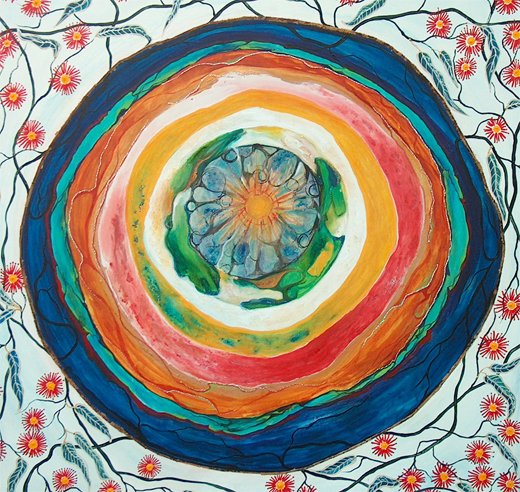|
Rainbow Dance |
|
|
|
Around
five minutes long, Rainbow Dance, the third movement, is a technically
challenging one, dealing with a complex subject. It focuses on the people
of Australia, who they are, their diverse roots, and the future they all
hold together. It is a tale of one nation made up of people from all walks
of life, all corners of the globe, so many varied religions and from
people that hold such different histories. Muta, a Murinbara man expressed this observation in the following phrase:
White man got no Dreaming. White man, him go ‘nother way. White man, him go different. Him got road belong himself.
What he meant by this is that ‘white’ peoples have no sustaining and binding (spiritual) vision – either between each other or between themselves and the land. Aboriginal peoples know that such a vision and way of living is essential for individual, social and ecological health. Non-aboriginal people, cannot, and need not, adopt Aboriginal spirituality as their own, just as it displaced the Aboriginal people to be forced to adopt white mans ways, but as all human beings are bound by one Earth, there is much that the wisdom of the Dreamtime legacy can teach us all. In western culture’s drive to ‘possess’ and unremittingly ‘develop’, to attempt to control Nature, to economically rationalise human and other life, to oppress indigenous peoples and other cultural minorities, much valuable knowledge and wisdom has been lost or forgotten. We need to understand the value of what we have lost as well as what we have gained in the name of ‘development’. Perhaps then it may be possible to retrieve what is needed for the land and the people to live in harmony once again, in ways that embrace contemporary and ancient understandings. As much as this story is valid for people the world over, in Australia it is now critically a time for us to acknowledge our collective inheritances, both positive and negative, to claim our independence and to responsibly come to terms with the past as best we may so that we can move into the future as a basically united, though diverse, nation. A nation bound by one land with many roots, a nation that offers hope for the dreams of future generations. Winanga-li endeavours to sound a note of celebration, amidst its pain and healing, for the extraordinary beauty and cultural richness that characterises this great land and all its people. |

